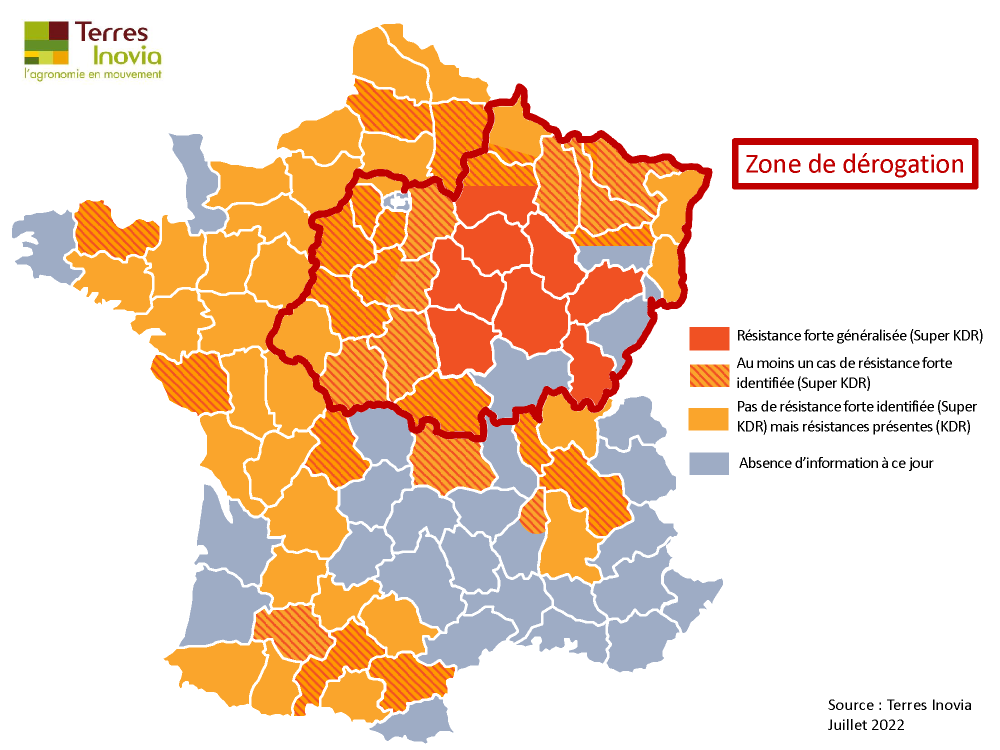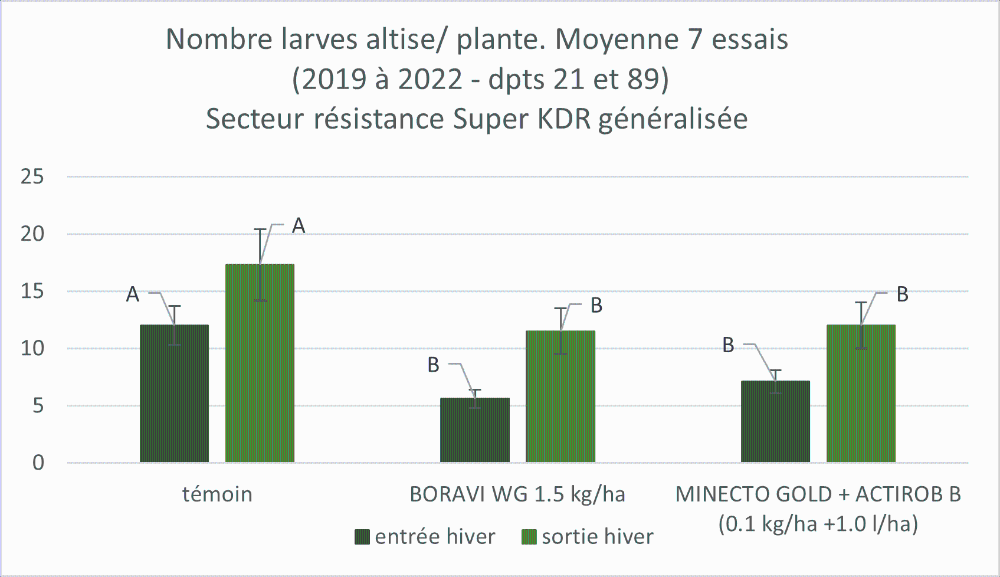Pyrethroids, Boravi WG, Minecto Gold: what's changing (or not) in terms of recommendations this fall
Pyrethroids, Boravi WG, Minecto Gold: what's changing (or not) in terms of recommendations this fall
The high pressure of winter flea beetle and terminal bud weevil as well as insecticide resistance can put oilseed rape under pressure. The control of these two autumn pests relies primarily on a combination of agronomic levers to limit the use of available insecticides. The recent withdrawal of the marketing authorisation for phosmet (BORAVI WG) seems to weaken the situation.
The notion of treatment threshold or intervention threshold is replaced by that of risk analysis, which integrates other components than just the level of infestation. Terres Inovia provides an update on risk assessment in the field and the insecticides to be used only as a last resort, when the situation requires it.
Insecticides as a last resort in a robust oilseed rape establishment process
The recent marketing authorisation (MA) as a derogation for a period of 120 days for the commercial product MINECTO Gold - s.a. cyantraniliprole - (art 53 REG 1107/2009) is limited to the regions Grand-Est, Bourgogne-Franche-Comté, Ile-de-France, Centre-Val-de-Loire and the department of Allier.
This authorisation does not change the strategy of evolution towards an agroecological transition and the reasoning of the control. The recommendations for insecticide protection against winter flea beetles and terminal bud weevil are inevitably part of a reasoning context that is particularly based on :
- the success or failure of the establishment of a robust oilseed rape ;
- observation of the crop, not just at a given moment, but throughout the autumn cycle;
- diagnosis of the presence/absence of insects or damage caused by these insects.
Simple and free digital OADs that integrate Terres Inovia's expertise
To assess the risk in the field, Terres Inovia has developed three decision support tools "Colza Risques" (freely available on www.terresinovia.fr ) to help farmers and technicians.
- OAD Adult flea beetles : aims to estimate the risk related to foliar sampling by adult diamondback and winter flea beetles, for emergence before 1 October.
- OAD Terminal bud weevils : is used in addition to the information provided by monitoring yellow tanks ideally positioned in a network (BSV type). Takes into account an agronomic risk, the captures in the tanks and the historical pressure of the plot;
- OAD Flea beetle larvae : is used from mid-November and takes into account the agronomic risk and the level of larval infestation (Berlèse test necessary).
For each of these OADs, the estimation of the global risk at the plot level is associated, if necessary, with a recommendation for insecticide control.
Terminal bud weevil and adult flea beetle: no change of insecticide strategy when needed!
*Against the terminal bud weevil, Even with the KDR mutation, the level of CBT resistance remains low. Pyrethroids remain effective.
Use an authorised pyrethroid such as lambda-cyhalothrin, deltamethrin or cypermethrin. Etofenprox has a lower level of efficacy.
*Against adult flea beetles...
If an intervention is necessary, apply a pyrethroid with good treatment conditions in the evening (the adult is active at the beginning of the night). BORAVI WG 1.0 kg/ha can be used until 1 November 2022.
For regions with widespread pyrethroid resistance, if BORAVI WG 1.0 kg/ha is no longer available, the only solution is early sowing and emergence.
This intervention on adults will have little impact on larval infestations which may be visible at the beginning of winter.
Flea beetle larvae, recommendations are changing.
Regardless of the region and the resistance present, only intervene after evaluating the risk in the field. This risk depends on the growth dynamics of the rape and the number of larvae (Berlèse test). The OAD " COLZA Risques larves de grosse altise " is freely available on the Terres Inovia website. When necessary, protection should be applied at the beginning of winter, during November to early December.
Our insecticide advice is evolving and takes into account the state of pyrethroid resistance, the MINECTO Gold derogatory MA between 15 October 2022 and 12 February 2023 (conditional on the carrying out of a berlèse test and a reasoned intervention according to the estimation of risk by the available decision support tools) and the issues linked to selection pressure:
| Colour code | Departments | Legend | Recommended products for flea beetle larvae |
|
| Departments | Generalized strong resistance (Super KDR). Pyrethroids are totally ineffective | Use MINECTO Gold during November to December from the 6-leaf stage |
|
| At least one case of strong resistance identified (Super KDR). High risk of pyrethroid resistance | Preferably use MINECTO Gold in November to December from the 6-leaf stage | |
| Other regions and departments than above | At least one case of strong resistance identified. Lower risk of resistance | Use a pyrethroid insecticide, preferably lambda-cyhalothrin | |
|
| No strong resistance identified (Super KDR) but resistance present (KDR) | ||
|
| No information to date |
Pyrethroid resistance in flea beetles

MINECTO Gold is equivalent to the historical reference BORAVI WG on flea beetle larvae in a generalized Super KDR situation (average of 7 trials - 2019 to 2022 - departments 21 and 89).
|
| MINECTO Gold Composition et formulation : |
Articles you may be interested in:
- Growing oilseed rape in 2023: the new deal – May, 2022
- Planting: the keys to robust oilseed rape – May, 2022
- Varieties to help control autumn pests – June, 2022
- The place of pre-emergence in oilseed rape herbicide programmes: managing grasses and limiting investment at sowing – July, 2022
- Ensuring good mineral nutrition of oilseed rape in the autumn to allow continuous growth until winter – August, 2022
- 120 day exemption for MINECTO Gold against flea beetle larvae in oilseed rape and mustard – September, 2022
Contacts : Laurent RUCK (l.ruck@terresinovia.fr), Jean LIEVEN (j.lieven@terresinovia.fr), Franck DUROUEIX (f.duroueix@terresinovia.fr)




